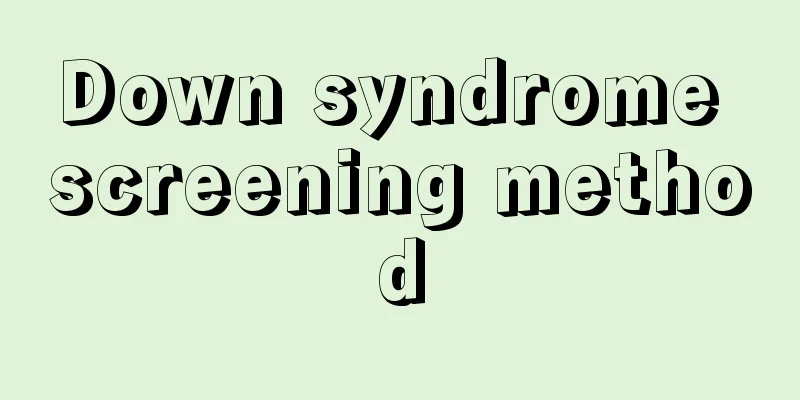Down syndrome screening method

|
Many parents have heard of Down syndrome, a disease that occurs in many children. However, some parents still have little knowledge about such diseases. Therefore, we need to seriously understand the knowledge of this disease. Once a baby has Down syndrome, parents are still very worried about the occurrence of this disease. Let's take a look at what authoritative experts say about the characteristics of Down syndrome in babies: What are the symptoms of Down syndrome in babies? 1. Down syndrome babies have low intelligence Children with Down syndrome have mild to moderate, and most have moderate mental retardation. Their intelligence gradually decreases with age. From 1 to 10 years old, their average IQ drops from 58 to below 40. Some experts also believe that IQ is relatively stable during adolescence and then decreases. Most studies have shown that environmental factors are important factors affecting IQ, and patients raised in a good environment have relatively higher IQ. The degree of intellectual disability may vary among different types of patients. Generally speaking, those with trisomy are the most serious, followed by those with translocation. Among translocation types, those with balanced translocation are less affected in terms of intelligence. Because the children are quiet and docile, they provide good conditions for special education training. Although it is difficult for them to reach the level of 1st to 2nd grade primary school in terms of cultural skills, their adaptability can be significantly improved, and they have a certain degree of self-care and labor ability. (Detailed explanation of Down syndrome!) 2. Language development disorder The average age when children start learning to speak is 4-6 years old, and 95% have pronunciation defects, unclear articulation, stuttering, and hoarse voices; more than 1/3 have abnormal speech rhythm and even explosive sounds. 3. Behavioral disorders Most of them are mild-tempered, often giggle, like to imitate and repeat simple movements, and can perform simple labor. A few patients are irritable, willful, hyperactive, and even have destructive and aggressive behaviors. Some show a tendency to shrink, accompanied by a catatonic posture. (What should I do if my baby doesn’t like to take medicine and spits it out once he takes it?) 4. Motor development retardation The motor function of children with this disorder may not be much different from that of normal children of the same age for a period of time after birth, but the difference increases with age. Motor development also varies greatly among different patients. Patients with congenital idiocy can perform simple movements, such as dressing and eating, but their movements are clumsy, uncoordinated, and their gait is unstable. 5. Growth and development disorders The maternal gestation period of patients with congenital idiocy is shorter, averaging 262-272 days. The height at birth is 1-3cm shorter than that of a normal newborn. The head circumference is basically normal, the biparietal diameter is within the normal range, the anterior-posterior diameter is relatively short, and the occipital part is flat. Most of them are brachycephalic. The anterior and posterior fontanelles and the frontal suture are wide and close slowly, and a third fontanelle (widening of the sagittal suture above the posterior fontanelle) often appears. Children with this disease sleep deeply for a few days after birth, and their sucking and swallowing are very slow, or even completely unable, so it is very difficult to wake them up and feed them. 80% of the children had generally low muscle tone. 6. Special appearance The eyes are widely spaced, with the outer corners of the eyes slanting upwards, epicanthus, low-set ears, low nose bridge, broad and thick tongue, mouth often half open or with tongue sticking out of the mouth, deep and numerous tongue grooves, thick palms and short and thick fingers, short last finger that is often bent inwards or has two joints, and 40% of children have palmar dysplasia. Among the plantar creases, there is an arch-shaped crease on the tibial side of the ball of the big toe, the distance between the big toe and the second toe is large, and the joint ligaments are loose or the muscle tone is low. 7. About 1/2 of the cases are complicated by congenital heart disease, susceptibility to infectious diseases and leukemia Please do some examinations during pregnancy on time and as required. This is an important method to screen for fetal diseases. If the fetus is found to be unhealthy, it is best to terminate the pregnancy. What are the characteristics of Down syndrome in infants? Through the above content, we also know that due to the special cause of Down syndrome in infants, there is no effective treatment method. We can only rely on prenatal screening during pregnancy for prevention. Since babies with Down syndrome often have intellectual disabilities and developmental delays, their parents and schools should help the children overcome some problems in daily life and behavior. At the same time, all sectors of society should give more care and help to babies with Down syndrome. |
<<: Why does a newborn baby breathe heavily when sleeping?
>>: What causes red spots on children?
Recommend
Baby's eyes turn purple
Adults are prone to dark circles due to frequent ...
How to whiten a child’s tanned skin?
There are a lot of people with dark skin, and the...
What should I do if my baby has a severe cold and a stuffy nose?
Babies play a very important connecting role in a...
What are the symptoms of cough mycoplasma infection in children?
Mycoplasma infection spreads very widely among ch...
What medicine should children take for bad breath?
As we all know, the digestive function of young c...
What are the developmental standards for a two-year-old baby?
What are the developmental standards for a two-ye...
Symptoms of chickenpox in children
Many children will get chickenpox when they are y...
What to do if infants and young children have yellow hair
Chinese people's hair is generally black, and...
What are the most effective treatments for athlete's foot in children?
Because the baby's own resistance is still re...
What are the symptoms of zinc deficiency in children?
Parents are very concerned about their children&#...
Symptoms of roseola infantum
For young children, mothers need to take good car...
What should I do if my baby has seasonal eczema?
Babies are the center of a family, and their heal...
What are the most nutritious foods for babies?
Everyone knows that newborn babies are very picky...
Six-year-old boy sweats while sleeping
Children are the people that their parents care a...
My child's arm suddenly hurts, what's going on?
The importance of every child to every family is ...









